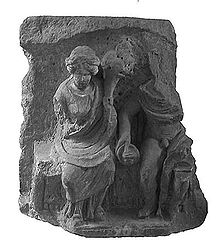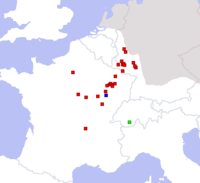
Rosmerta
Encyclopedia

In Gallo-Roman religion
Gallo-Roman religion
Gallo-Roman religion was a fusion of the traditional religious practices of the Gauls, who were originally Celtic speakers, and the Roman and Hellenistic religions introduced to the region under Roman Imperial rule. It was the result of selective acculturation....
, Rosmerta was a goddess of fertility and abundance, her attributes being those of plenty such as the cornucopia
Cornucopia
The cornucopia or horn of plenty is a symbol of abundance and nourishment, commonly a large horn-shaped container overflowing with produce, flowers, nuts, other edibles, or wealth in some form...
. Rosmerta is attested by statues, and by inscriptions. In Gaul
Gaul
Gaul was a region of Western Europe during the Iron Age and Roman era, encompassing present day France, Luxembourg and Belgium, most of Switzerland, the western part of Northern Italy, as well as the parts of the Netherlands and Germany on the left bank of the Rhine. The Gauls were the speakers of...
she was often depicted with the Roman god Mercury
Mercury (mythology)
Mercury was a messenger who wore winged sandals, and a god of trade, the son of Maia Maiestas and Jupiter in Roman mythology. His name is related to the Latin word merx , mercari , and merces...
as her consort, but is sometimes found independently.
Iconography
A relief from AutunAutun
Autun is a commune in the Saône-et-Loire department in Burgundy in eastern France. It was founded during the early Roman Empire as Augustodunum. Autun marks the easternmost extent of the Umayyad campaign in Europe.-Early history:...
(ancient Augustodunum, the civitas
Civitas
In the history of Rome, the Latin term civitas , according to Cicero in the time of the late Roman Republic, was the social body of the cives, or citizens, united by law . It is the law that binds them together, giving them responsibilities on the one hand and rights of citizenship on the other...
capital of the Celtic Aedui
Aedui
Aedui, Haedui or Hedui , were a Gallic people of Gallia Lugdunensis, who inhabited the country between the Arar and Liger , in today's France. Their territory thus included the greater part of the modern departments of Saône-et-Loire, Côte-d'Or and Nièvre.-Geography:The country of the Aedui is...
), shows Rosmerta and Mercury seated together as a divine couple (see above). She holds a cornucopia
Cornucopia
The cornucopia or horn of plenty is a symbol of abundance and nourishment, commonly a large horn-shaped container overflowing with produce, flowers, nuts, other edibles, or wealth in some form...
, with Mercury holding a patera
Patera
A patera was a broad, shallow dish used for drinking, primarily in a ritual context such as a libation. These paterae were often used in Rome....
at her left side.
A bas-relief from Eisenberg
Eisenberg
-In Germany:*Eisenberg, Thuringia, a town in the Saale-Holzland district, Thuringia.*Eisenberg, Rhineland-Palatinate, a town in the Donnersbergkreis, Rhineland-Palatinate.*Eisenberg, Bavaria, a municipality in the district of Ostallgäu in Bavaria.-In Austria:...
(see left) shows the couple in the same relative positions, with Rosmerta securely identified by the inscription. Rosmerta holds a purse in her right hand and a patera
Patera
A patera was a broad, shallow dish used for drinking, primarily in a ritual context such as a libation. These paterae were often used in Rome....
in her left.
In a pair of statues from Paris depicting the couple, Rosmerta holds a cornucopia and a basket of fruits.
Rosmerta is shown by herself on a bronze statue from Fins d'Annency, where she sits on a rock holding a purse and, unusually, also bears the wings of Mercury on her head. A stone bas-relief from Escolives-Sainte-Camille
Arrondissement of Auxerre
The arrondissement of Auxerre is an arrondissement of France, located in the Yonne département, in the Bourgogne région. It has 22 cantons and 196 communes.-Cantons:The cantons of the arrondissement of Auxerre are:# Aillant-sur-Tholon...
shows her bolding both a patera and a cornucopia.
Inscriptions

Roman province
In Ancient Rome, a province was the basic, and, until the Tetrarchy , largest territorial and administrative unit of the empire's territorial possessions outside of Italy...
s of Gallia Belgica
Gallia Belgica
Gallia Belgica was a Roman province located in what is now the southern part of the Netherlands, Belgium, Luxembourg, northeastern France, and western Germany. The indigenous population of Gallia Belgica, the Belgae, consisted of a mixture of Celtic and Germanic tribes...
and Germania Superior
Germania Superior
Germania Superior , so called for the reason that it lay upstream of Germania Inferior, was a province of the Roman Empire. It comprised an area of western Switzerland, the French Jura and Alsace regions, and southwestern Germany...
. An additional two inscriptions are known, one from Roman Dacia
Roman Dacia
The Roman province of Dacia on the Balkans included the modern Romanian regions of Transylvania, Banat and Oltenia, and temporarily Muntenia and southern Moldova, but not the nearby regions of Moesia...
.
An inscription from Metz
Metz
Metz is a city in the northeast of France located at the confluence of the Moselle and the Seille rivers.Metz is the capital of the Lorraine region and prefecture of the Moselle department. Located near the tripoint along the junction of France, Germany, and Luxembourg, Metz forms a central place...
is a dedication (votum
Votum
In ancient Roman religion, a votum, plural vota, is a vow or promise made to a deity. The word comes from the past participle of the Latin verb voveo, vovere, "vow, promise." As the result of this verbal action, a votum is also that which fulfills a vow, that is, the thing promised, such as...
) to Mercury and Rosmerta jointly. Another from Eisenberg was made by a decurion in fulfillment of a vow to the couple jointly.
In two inscriptions both from Gallia Belgica, Rosmerta is given the epithet sacra, sacred. A lengthier inscription from Wasserbillig in Gallia Belgica associates the divine couple with the dedication of a shrine (aedes
Aedes
Aedes is a genus of mosquito originally found in tropical and subtropical zones, but now found on all continents excluding Antarctica. Some species have been spread by human activity. Aedes albopictus, a most invasive species was recently spread to the New World, including the U.S., by the used...
), with "hospitable" rites to be celebrated.
Etymology
The name Rosmerta is GaulishGaulish language
The Gaulish language is an extinct Celtic language that was spoken by the Gauls, a people who inhabited the region known as Gaul from the Iron Age through the Roman period...
, and is analysed as ro-smert-a. Smert means 'provider' or 'carer' and is also found in other Gaulish names such as Ad-smerio, Smertu-litani, Smerius, Σμερο, Smertae, Smertus, etc. Ro- is a modifier meaning 'very' 'great' or 'most' as found in Ro-bili ('most-good'), Ro-cabalus ('great horse'), Ρο-βιος ('great life'). The -a ending is the typical Gaulish feminine singular nominative. The meaning is thus 'the Great Provider.'

